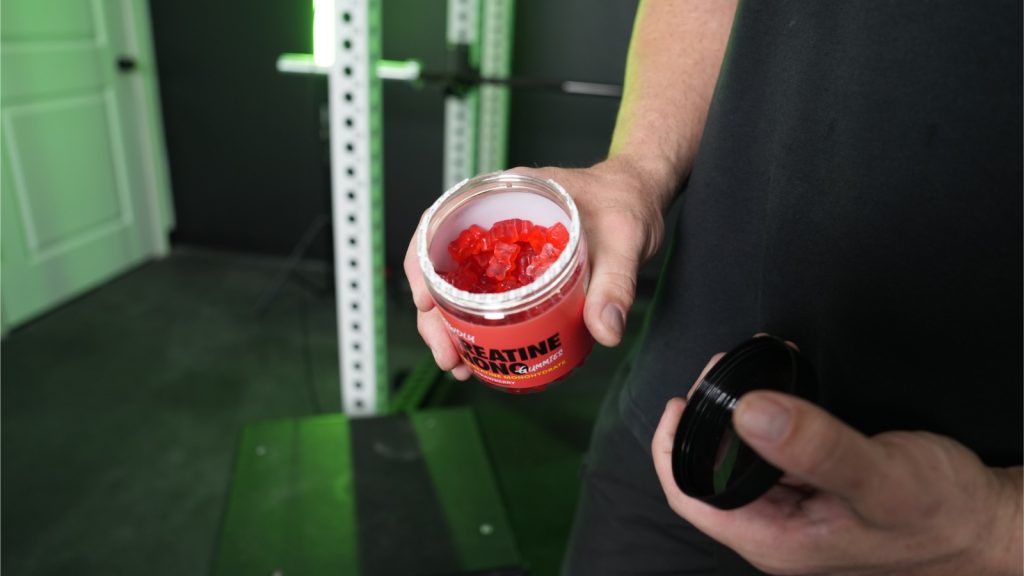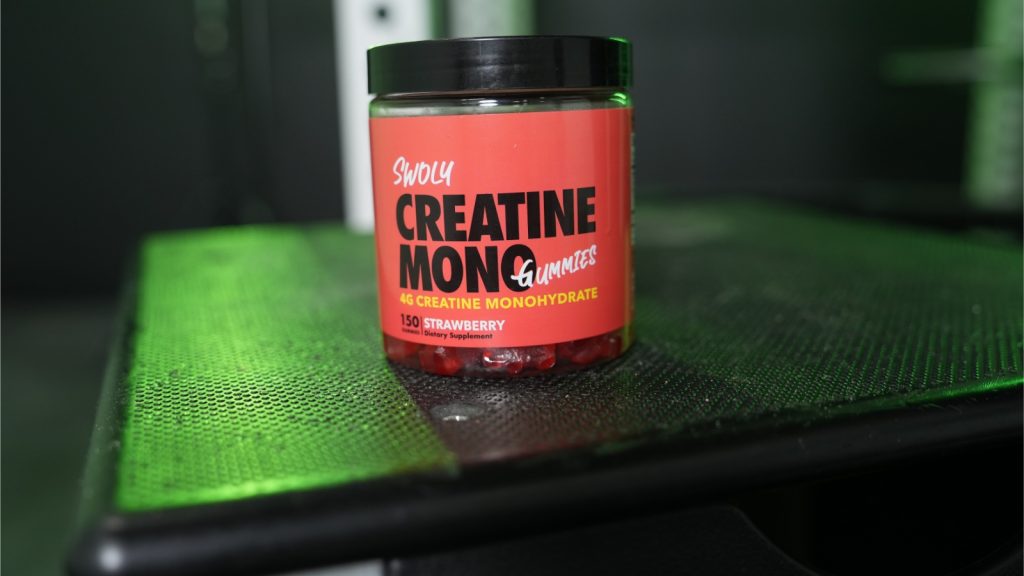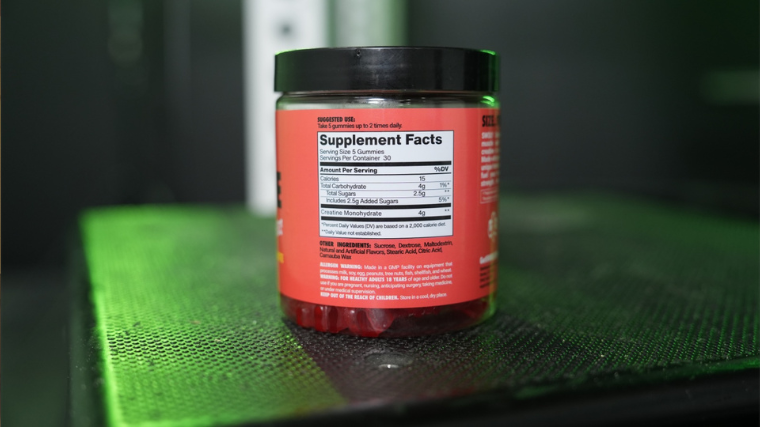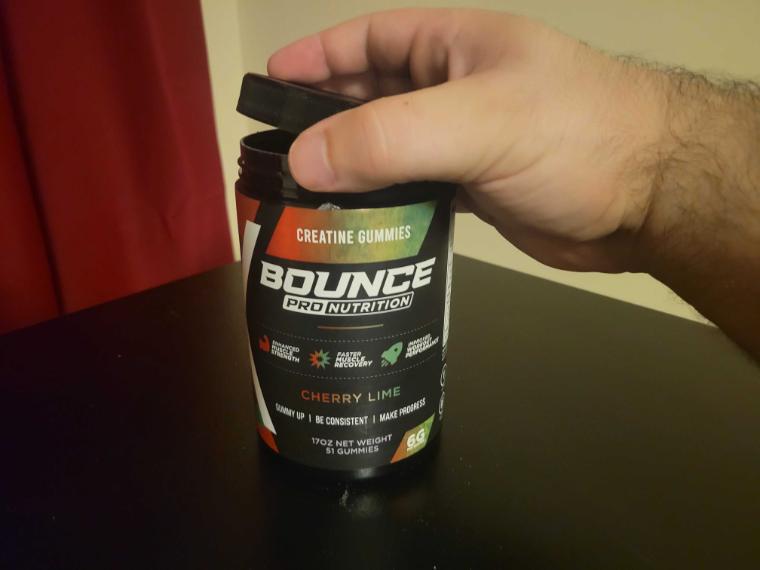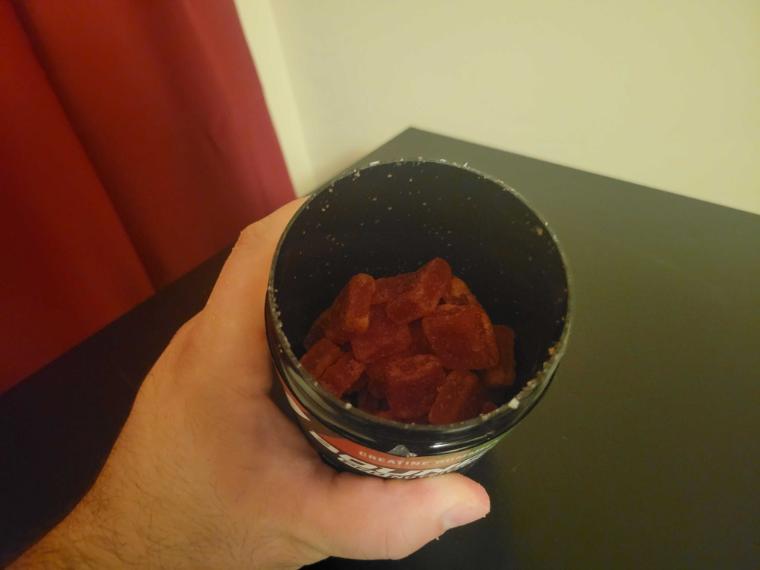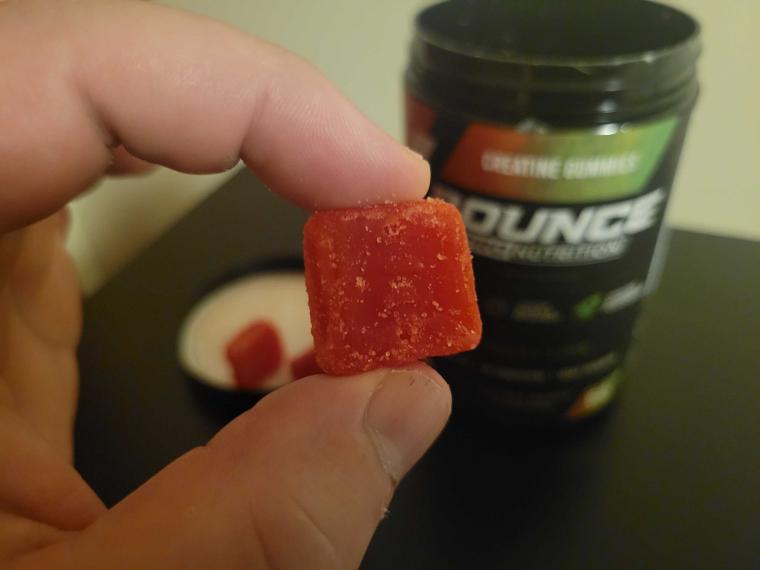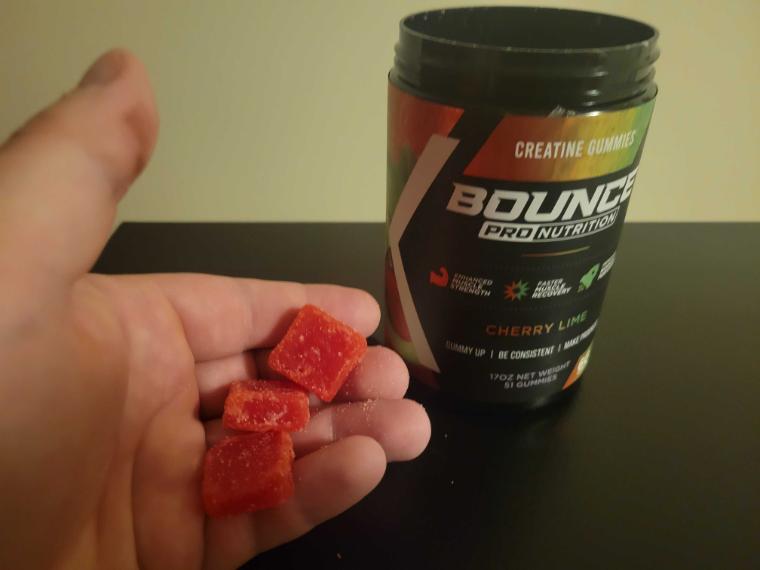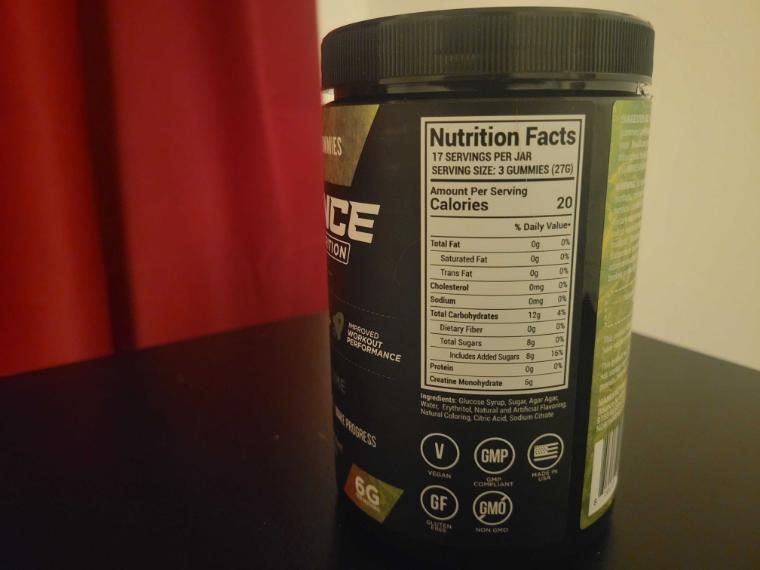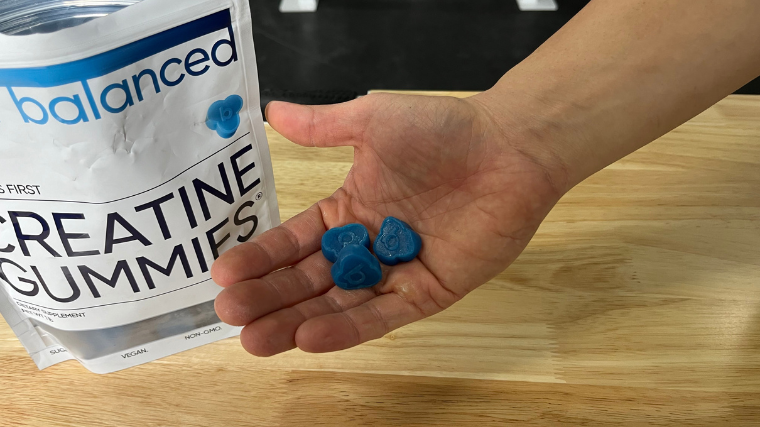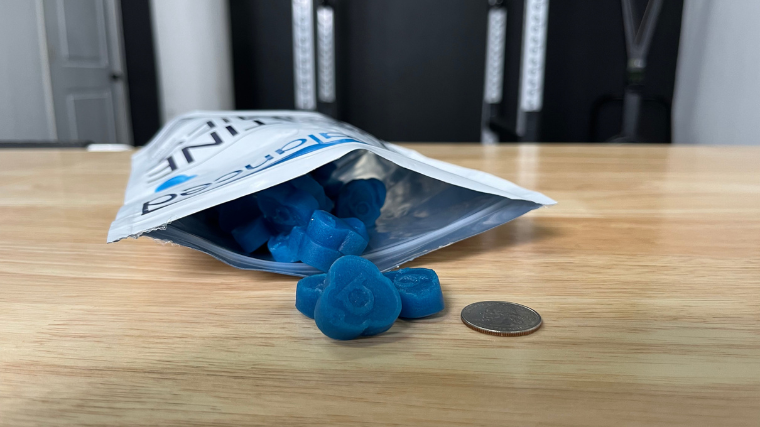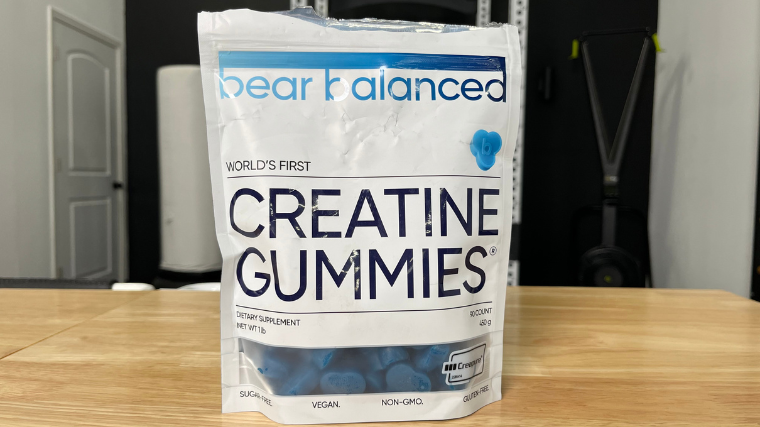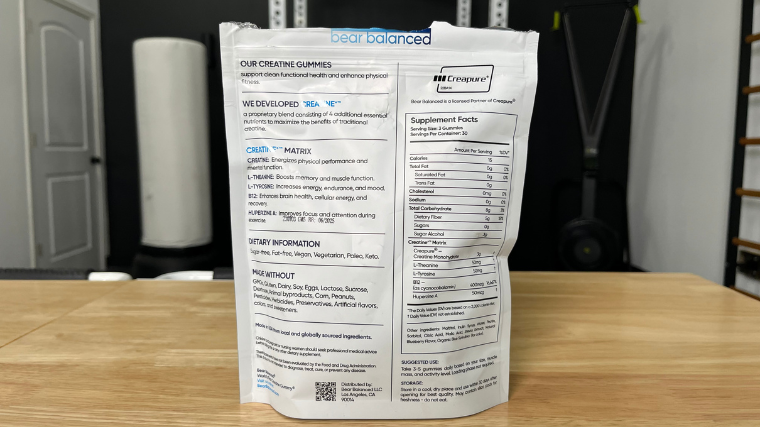Creatine is one of the most popular supplements on the market, and we get why — it helps increase energy to your muscle cells during workouts by increasing the supply of creatine phosphate. (1) Creatine monohydrate, which is the active ingredient in all our picks on this list, is also the most researched form of creatine for athletic performance. (2) But even the best creatine supplements can turn into a chalky mess when they’re in powder form. Before you give up on creatine altogether, we think you should give creatine gummies a try.
The best creatine gummies offer a unique method for performance-boosting supplementation. That said, finding your best pick is more than choosing an enjoyable flavor. To help, our expert team — consisting of certified personal trainers, nutrition coaches, and lifelong fitness enthusiasts — has researched and examined over 40 high-quality creatine supplements (gummies included), using our supplement testing methodology to curate this guide. Ready to bite into refreshed supplementation? Let’s get into our findings.
The 8 Best Creatine Gummies of 2025
- Best Creatine Gummies Overall: Legion Naturally Sweetened & Flavored Creatine Monohydrate Gummies
- Best Creatine Gummies on Amazon: Jacked Factory Creatine Gummies
- Best Creatine Chews: Swoly Creatine Gummies
- Best Creatine Gummies with Flavor Options: Bounce Nutrition Creatine Gummies
- Best Vegan Creatine Gummies: Create Creatine Gummies
- Best-Tasting Creatine Gummies: Organifi Creatine Cherry Chews
- Best Budget Creatine Gummies: Animal Creatine Performance Chews
- Best Sugar-Free Creatine Gummies: Bear Balanced Creatine Gummies
Medical Disclaimer: The content on BarBend is meant to be informative in nature, but it should not be taken as medical advice. The opinions and articles on this site are not intended for use as diagnosis, prevention, and/or treatment of health problems. It’s always a good idea to talk to your doctor before beginning a new fitness, nutritional, and/or supplement routine. Individual needs for vitamins and minerals will vary.
Best Creatine Gummies Overall: Legion Naturally Sweetened & Flavored Creatine Monohydrate Gummies
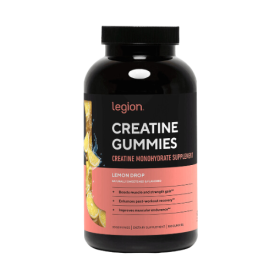
Legion Naturally Sweetened & Flavored Creatine Monohydrate Gummies are made with all-natural ingredients and the brand provides plenty of research to support their formula.
Specs
- Price Per Serving: $1.15
- Creatine Per Serving: 5g
- Creatine Type: Creatine monohydrate
- Available Flavors: Lemon Drop, Sour Blue Raspberry, Sour Watermelon, Sour Green Apple
- Servings Per Container: 30 servings
- Dietary Specifications: Gluten-free, vegan
Best Creatine Gummies on Amazon: Jacked Factory Creatine Gummies

Containing 5 grams of creatine monohydrate per five-gummy serving, Jacked Factory Creatine Gummies can be a fun, effective supplement for your daily routine. The texture is (naturally) chewy, according to our tester, and we appreciate the range of flavors that span classic tastes such as Blue Raspberry, Lemon, and Watermelon.
Specs
- Price Per Serving: $1.00
- Creatine Per Serving: 5g
- Creatine Type: Creatine monohydrate
- Available Flavors: Blue Raspberry, Lemon, Watermelon
- Servings Per Container: 30 servings
- Dietary Specifications: Gluten-free, vegan
Best Creatine Chews: Swoly Creatine Gummies
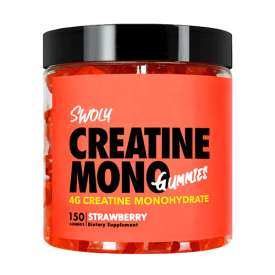
These gummies boast 4g of creatine monohydrate and come in a delicious strawberry flavor. You do need to chew 5 for a full dose, but they're so tasty, we don't think you'll have any complaints about that.
Specs
- Price Per Serving: $1 to $1.16
- Creatine Per Serving: 4g
- Creatine Type: Creatine monohydrate
- Available Flavors: Strawberry
- Servings Per Container: 30 servings
- Dietary Specifications: Gluten-free
Best Creatine Gummies with Flavor Options: Bounce Nutrition Creatine Gummies
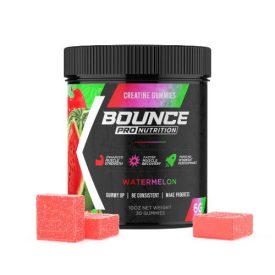
Bounce Nutrition Creatine Gummies provide 6g of creatine per serving in a non-melt gummy format. With six vegan-friendly flavors to choose from, this chewable creatine supplement makes it easy and tasty to get your daily dose of creatine.
Specs
- Price Per Serving: $2.29 to $2.80
- Creatine Per Serving: 6g
- Creatine Type: Creatine monohydrate
- Available Flavors: Blue Razz, Strawberry Kiwi, Berry Snow Cone, Watermelon, Peach Rings, Cherry Lime
- Servings Per Container: 10, 17, or 24
- Dietary Specifications: Gluten-free, allergen-free, vegan
Best Vegan Creatine Gummies: Create Creatine Gummies
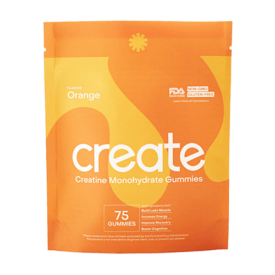
Crafted for balance, taste, and ease, Create Gummies revolutionize creatine supplementation with delicious 1g gummies. Turn routine into a treat and fuel your body for performance. Use code "intro20" for a 20% discount.
Specs
- Price Per Serving: $2 to $2.33
- Creatine Per Serving: 4.5g
- Creatine Type: Creatine monohydrate
- Available Flavors: Orange, Blue Raspberry, Watermelon, Sour Green Apple, Sour Cherry
- Servings Per Container: 30 servings
- Dietary Specifications: Gluten-free, vegan
Best-Tasting Creatine Gummies: Organifi Creatine Cherry Chews
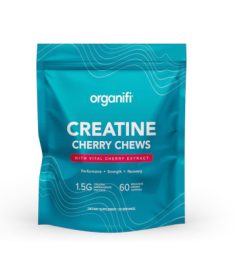
Organifi Cherry Creatine Chews make taking creatine feel like a treat thanks to their candy-like cherry flavor and convenient chewable format. They’re plant-based, easy to take on the go, and offer 3g of creatine per serving.
Specs
- Price Per Serving: $1.43
- Creatine Per Serving: 3g
- Creatine Type: Creatine monohydrate
- Available Flavor: Cherry
- Servings Per Container: 30 servings
- Dietary Specifications: Gluten-free, soy-free
Best Budget Creatine Gummies: Animal Creatine Performance Chews
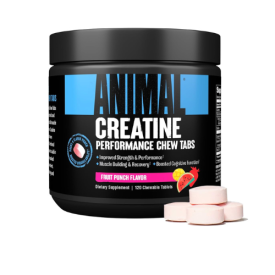
Animal Creatine Performance Chews offer a convenient and enjoyable way to supplement with 5 grams of creatine monohydrate per serving, complemented by Astragin for enhanced absorption. These chewable tablets come in four flavors, providing an alternative to gummies and powders. With a texture reminiscent of Sweet Tarts and supported by research, this formulation aims to boost muscle creatine levels and enhance athletic performance.
Specs
- Price Per Serving: $0.99 to $1.10
- Creatine Per Serving: 5g
- Creatine Type: Creatine monohydrate
- Available Flavors: Fruit Punch, Grape, Candy Crush’d, Lemon Ice
- Servings Per Container: 30 servings
- Dietary Specifications: Gluten-free, vegan
Best Sugar-Free Creatine Gummies: Bear Balanced Creatine Gummies
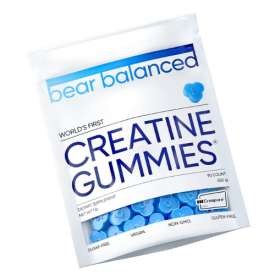
For those who don't want to add yet another powder to their supplement stack, we highly recommend Bear Balanced Creatine Gummies. These come in a blueberry flavor and are easy to take on-the-go.
Specs
- Price Per Serving: $1.60 to $2
- Creatine Per Serving: 3 grams
- Creatine Type: Creatine monohydrate
- Available Flavors: Blueberry, Peach Mango, Watermelon Burst
- Servings Per Container: 30 servings
- Dietary Specifications: Gluten-free, vegan
Other Creatine Gummies We’ve Tested
Some gummies can make consuming your daily creatine into a ‘lil treat. Others, not so much. See some other creatine gummies we’ve tested below.
- Icon Muscle Creatine Gummies: We like that these gummies come in a variety of flavors, but the sugar levels are off the charts here. Also, you’ll need to take several gummies to reach the clinically recommended dose of 5 grams of creatine per serving, which means each bottle won’t last you very long.
How We Tested and Chose the Best Creatine Gummies
The BarBend team is made up of competitive athletes, certified personal trainers, and lifelong fitness enthusiasts. To determine the best creatine gummies available today, we’ve tested 41 different profiles from the industry’s best brands, using a multi-point supplement testing methodology to rate each profile on a scale of 1 (lowest) to 5 (highest). Below are some of the categories and components that played into our rankings.
- Formulation: While creatine monohydrate is the most well-researched form of creatine, there are many types of creatine including creatine HCl, creatine HMB, micronized creatine, and creatine nitrate, to name a few. (2)
- Dosage: We also evaluated the amount of creatine in each supplement. For general wellness, studies show that you need about 3 to 5 grams of creatine intake, which every pick on this list contains. (3)
- Ingredients: When choosing our picks, we like to avoid creatine supplements that contain fillers, artificial ingredients, added sugars, and sugar alcohols.
- Third-Party Testing: Dietary supplements and any accompanying claims are not evaluated by the United States Food and Drug Administration. This means that manufacturers can pretty much claim anything on the label. That’s why looking for reputable, third-party testing companies or third-party certifications on the label is so important in your search for high-quality creatine gummies.
- Value: Hey, who doesn’t love a good deal? On our list, we’ve tried to point out the picks that are the best value for your money.
Benefits of Creatine Gummies
There are both pros and cons associated with taking creatine gummies, but mostly positive benefits from regular creatine use. Gummies can also be more convenient and delicious when compared to other forms of creatine. Additionally, creatine gummies may be able to fuel your workout and fitness goals. Read on to understand the full benefits of creatine gummies.

- Convenient: Whether you keep your creatine supplements in the pantry or your gym bag, creatine gummies have you covered. Pre-portioned gummy servings eliminate the need for measuring or mixing, saving time and effort for individuals with busy lifestyles. This added convenience may help you keep your creatine supplementation more consistent. After all, studies show that people are more likely to adhere to taking gummies than other forms of supplements. (5)
- Tasty: Powders can be chalky and may often have an unpleasant flavor or aftertaste – and it’s the reason why some of us might have previously avoided taking creatine altogether. Fortunately, creatine gummies come in a variety of flavors, depending on the brand, that can appeal to a range of preferences since taste is subjective. Look for a flavor that you know you’ll enjoy, and it’ll make taking your creatine gummies that much easier.
- Increased Recovery from Workouts: Creatine is known for increasing strength and athletic performance, and part of this is due to its ability to promote recovery. Creatine has been shown to speed up recovery between training sessions by reducing muscle damage and promoting the recovery of lost force production potential. (1)
- Helps Drive Muscle Mass: Creatine monohydrate, the type of creatine found in the gummies in our list, can help support increases in muscle mass when paired with resistance training. Not only will you enjoy more strength and power during training, but you’ll be able to build more muscle. (2)
- Supports Exercise Performance: Creatine gummies contain creatine as the active ingredient, so the same benefits of creatine powder apply when it comes to athletic performance. Creatine supplies energy to your muscle cells by producing more adenosine triphosphate (ATP) during high-intensity exercise, such as running or resistance training in a HIIT format. By increasing your body’s supply of creatine phosphate, creatine gummies can help increase strength and power during exercise and may improve your performance. (1) Creatine may also help support muscle growth and muscle strength since it’ll give you energy to do some extra reps. (15) In addition to exercise, creatine supplementation can increase brain creatine, which improves brain function, neurological performance, and cognitive processing. (19)
How Much Do Creatine Gummies Cost?
The cost for creatine gummies ranges from $1 to $2 per serving, depending on the brand, ingredients, and other factors. If you’re looking for the best budget-friendly creatine gummies, Animal Creatine Performance Chews are our top pick. Make sure you are looking at the price per serving and not the price per gummy, as serving sizes can vary by product – some products have a two-gummy serving size, while others have a five-gummy serving size.
Creatine Gummies vs. Creatine Powder
While creatine has been a popular supplement for quite a while now, it’s typically consumed in powder or capsule form, and creatine gummies have recently become a popular alternative.
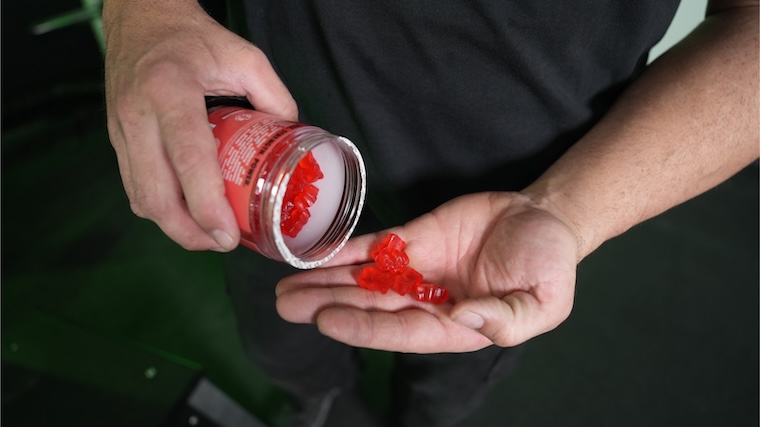
So which is better, and which you should choose?
“Extensive data has shown creatine monohydrate to support exercise training, performance, and recovery, and it can help increase exercise training volume and intermittent exercise performance and may accelerate the recovery from exercise,” according to Abbie E. Smith-Ryan, Ph.D., CSCSD, Professor and Director of Applied Physiology Laboratory Department of Exercise & Sport Science at the University of North Carolina.
Creatine monohydrate is the form used in all of the gummies on our list and is generally considered to be the most effective and well-researched form of creatine.
There’s no direct research comparing powder to gummies, but according to Dr. Smith-Ryan, creatine absorption may be enhanced when consumed along with carbohydrates. Fortunately, several of the gummies on our list include carbohydrates that may enhance absorption.
Since the effectiveness is likely similar between the two, the next factor to consider is taste and convenience. While some may find that adding a scoop of creatine monohydrate to a protein shake or morning coffee is the most convenient option, many people find the gritty, powdery texture to be unpleasant.
As Dr. Smith-Ryan pointed out, those who are unlikely to consume a powdered supplement on a regular basis may find gummies much more enjoyable, making them more likely to consume them on a daily basis. They’re also very convenient to carry around, and having a few gummies once per day can feel like a small treat.
Finally, we need to consider the price. Plain creatine monohydrate is typically a very affordable supplement, and while most of the gummies on our list are reasonably priced compared to other supplements like protein powder, they’re significantly more expensive than most creatine monohydrate powders.
If cost is a concern, you may want to stick with creatine powder instead of choosing the gummies.
Cons of Creatine Gummies
While we love snacking on creatine gummies, they aren’t for everyone, and there are a few negatives to consider before purchasing anything.
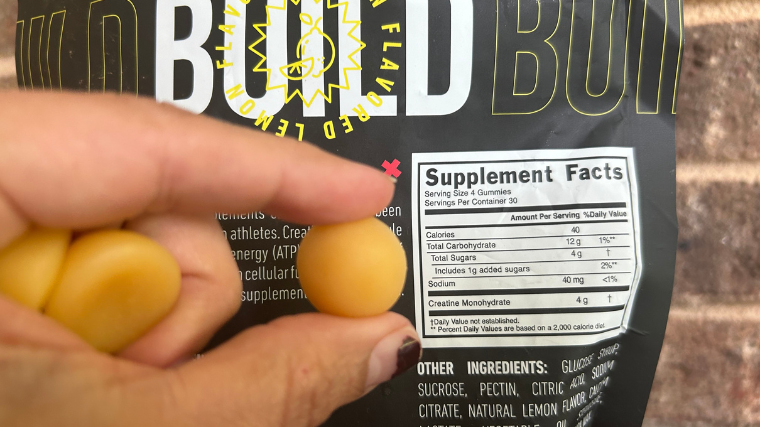
- More Expensive: Compared to a plain creatine monohydrate powder, gummies will almost always be more expensive. This makes sense due to the additional ingredients and processing required to make gummies, but it’s worth considering, especially if you’re already taking quite a few supplements on a regular basis.
- Larger Serving Size: Most people should aim for 3-5 grams of creatine monohydrate per day, and when using a powder, a 5-gram scoop is quite small. On the other hand, most gummies require you to take three to five gummies to get the full serving size. If you enjoy the gummies, this probably won’t be a big deal, but it’s worth pointing out.
- May Cause Bloating: Finally, the most common side effect of using any type of creatine monohydrate, whether it’s gummies or powder, is water retention and bloating. This typically goes away once your body is accustomed to the creatine, but it can be unpleasant, especially if you use a creatine loading phase, which involves taking 20-25 grams per day for the first 5-7 days before returning to a daily 5-gram maintenance dose.
How to Choose Creatine Gummies
Don’t see a creatine gummy on our list that fits your needs or see one in the store that you might be interested in? When choosing the best creatine gummies to incorporate into your supplementation routine, there are several factors to consider: type and amount of creatine, ingredient list quality, taste and flavor, and credibility. By carefully evaluating these factors, you’ll be able to confidently choose creatine gummies that best support your fitness goals and overall well-being.
- Creatine Type: The most common type of creatine formulation is creatine monohydrate, which is the most well-researched and cost-effective form. (2) A few examples are creatine hydrochloride (HCl), creatine nitrate, creatine ethyl ester, creatine citrate, and buffered forms like Kre-Alkalyn. Realistically, for most people, monohydrated creatine gets the job done – usually at a lower cost. The more high-end formulations may have slightly different absorption profiles, but they typically don’t outperform the former monohydrate in high-quality studies. (16)
- Creatine Amount: For creatine gummies to support your performance, studies recommend taking 3 to 5 grams of creatine per day. (3) Some creatine gummies might be cheaper, but make sure that each serving supplies at least 3 grams of creatine to meet that threshold. However, bodybuilders looking to gain lean muscle, power athletes looking to increase strength, or active individuals engaging in high-intensity exercise may need more creatine. Some studies have been done to assess performance in individuals taking up to 20 grams of creatine per day. (3)
- Ingredient List: Creatine gummies are a tough one to evaluate when it comes to ingredients because there are certain ingredients needed to create the gummy base (either gelatin or pectin) and to help stabilize the gummy from an acidity and shelf life perspective that would typically be considered fillers. If your preference is a gummy, make sure that even if there are fillers, they are natural and recognizable.
- Taste and Flavor: Most creatine gummies come in fruit or sweet-and-sour candy flavors. If you normally like a certain fruit or candy flavor, you may like that same flavor in a gummy form. Also, be sure to check out online reviews to see what customers are saying. Until you know that a certain gummy is to your liking, you may want to stick with one jar – which is usually 30 servings – before you buy in bulk.
Best Creatine Gummies FAQs
Are there side effects from taking creatine gummies?
Yes, there can be. Creatine gummies are generally safe and well-tolerated for most healthy people. Creatine has been researched extensively, and at normal doses, serious side effects are pretty rare. (2) Some users may experience minor issues when they first start taking it, especially if they do the loading phase of taking a higher dose. The most common complaints are gastrointestinal symptoms like stomach cramps, diarrhea, or muscle cramps. But these are usually just temporary inconveniences as your body adjusts to the creatine.
Another side effect you might notice in the beginning is a bit of weight gain. But before you freak out, this isn’t fat weight – it’s just temporary water weight. To mitigate any side effects, try to start with a lower dose and work your way up from there.
Are creatine gummies as effective as powders?
There is currently no research directly comparing creatine gummies vs. powder. However, most gummies use creatine monohydrate, a highly absorbable and effective form of creatine, so you’re likely going to see all of the same benefits as long as you’re getting at least 3-5 grams of creatine per day from gummies. In addition, many gummies may contain carbohydrates, which can help increase the absorption of your creatine.
Do creatine gummies actually work?
Yes. Creatine gummies can provide the appropriate dosage of creatine monohydrate. Whether you’re consuming creatine as a powder, capsule, or in gummy form, it’s meant to be consumed orally so your digestive system can absorb it. As long as you’re getting an adequate daily dose of creatine each day, you can expect to see all of the benefits, even if you’re taking creatine in gummy form.
What is creatine?
Creatine is a naturally occurring substance found in skeletal muscle and the brain. Your body can produce small amounts of creatine each day, and it can also be consumed through foods like red meat and fish, as well as taken in supplement form, whether that’s a powder, capsule, or gummy.
Within the body, creatine helps your muscles produce more energy during high-intensity, short-duration forms of exercise, like sprinting, jumping, and weightlifting. When used as a dietary supplement, creatine monohydrate can increase strength, power, and muscle mass, improve recovery time between workouts, and support cognitive health and neurological performance.
References
- Wax, B., Kerksick, C. M., Jagim, A. R., Mayo, J. J., Lyons, B. C., & Kreider, R. B. (2021). Creatine for Exercise and Sports Performance, with Recovery Considerations for Healthy Populations. Nutrients, 13(6), 1915.
- Kreider, R. B., Kalman, D. S., Antonio, J., Ziegenfuss, T. N., Wildman, R., Collins, R., Candow, D. G., Kleiner, S. M., Almada, A. L., & Lopez, H. L. (2017). International Society of Sports Nutrition position stand: safety and efficacy of creatine supplementation in exercise, sport, and medicine. Journal of the International Society of Sports Nutrition, 14, 18.
- Ribeiro, F., Longobardi, I., Perim, P., Duarte, B., Ferreira, P., Gualano, B., Roschel, H., & Saunders, B. (2021). Timing of Creatine Supplementation around Exercise: A Real Concern?. Nutrients, 13(8), 2844.
- Wu, S. H., Chen, K. L., Hsu, C., Chen, H. C., Chen, J. Y., Yu, S. Y., & Shiu, Y. J. (2022). Creatine Supplementation for Muscle Growth: A Scoping Review of Randomized Clinical Trials from 2012 to 2021. Nutrients, 14(6), 1255.
- Wagner, C. L., Shary, J. R., Nietert, P. J., Wahlquist, A. E., Ebeling, M. D., & Hollis, B. W. (2019). Bioequivalence Studies of Vitamin D Gummies and Tablets in Healthy Adults: Results of a Cross-Over Study. Nutrients, 11(5), 1023.
- EFSA Panel on Nutrition, Novel Foods and Food Allergens (NDA), Turck, D., Castenmiller, J., De Henauw, S., Hirsch-Ernst, K. I., Kearney, J., Maciuk, A., Mangelsdorf, I., McArdle, H. J., Naska, A., Pelaez, C., Pentieva, K., Siani, A., Thies, F., Tsabouri, S., Vinceti, M., Cubadda, F., Engel, K. H., Frenzel, T., Heinonen, M., … Knutsen, H. K. (2020). Safety of a botanical extract derived from Panax notoginseng and Astragalus membranaceus (AstraGin™) as a novel food pursuant to Regulation (EU) 2015/2283. EFSA journal. European Food Safety Authority, 18(5), e06099.
- Tedner, S. G., Asarnoj, A., Thulin, H., Westman, M., Konradsen, J. R., & Nilsson, C. (2022). Food allergy and hypersensitivity reactions in children and adults-A review. Journal of internal medicine, 291(3), 283–302.
- U.S. Department of Agriculture and U.S. Department of Health and Human Services. Dietary Guidelines for Americans, 2020-2025. 9th Edition.
- Lenhart, A., & Chey, W. D. (2017). A Systematic Review of the Effects of Polyols on Gastrointestinal Health and Irritable Bowel Syndrome. Advances in nutrition (Bethesda, Md.), 8(4), 587–596.
- Marcason W. (2004). What do “net carb”, “low carb”, and “impact carb” really mean on food labels?. Journal of the American Dietetic Association, 104(1), 135.
- Wu G. (2009). Amino acids: metabolism, functions, and nutrition. Amino acids, 37(1), 1–17.
- U.S. Department of Health & Human Services. (2024). National Institutes of Health. Vitamin B12 Fact Sheet for Health Professionals.
- Huperzine A. (2004). Drugs in R&D, 5(1), 44–45.
- Wang, T., Masedunskas, A., Willett, W. C., & Fontana, L. (2023). Vegetarian and vegan diets: benefits and drawbacks. European heart journal, 44(36), 3423–3439.
- Nissen, S. L., & Sharp, R. L. (2003). Effect of dietary supplements on lean mass and strength gains with resistance exercise: a meta-analysis. Journal of applied physiology (Bethesda, Md. : 1985), 94(2), 651–659.
- Butts, J., Jacobs, B., & Silvis, M. (2018). Creatine Use in Sports. Sports health, 10(1), 31–34.
- Antonio, J., Candow, D. G., Forbes, S. C., Gualano, B., Jagim, A. R., Kreider, R. B., Rawson, E. S., Smith-Ryan, A. E., VanDusseldorp, T. A., Willoughby, D. S., & Ziegenfuss, T. N. (2021). Common questions and misconceptions about creatine supplementation: what does the scientific evidence really show?. Journal of the International Society of Sports Nutrition, 18(1), 13.
- Haff, G. G., Kirksey, K. B, Stone, M. H., Warren, B. J., Johnson, R. L., Stone, M., O’Bryant, H., & Proulx, C. (2000). The Effect Of 6 Weeks of Creatine Monohydrate Supplementation On Dynamic Rate of Force Development. Journal Of Strength And Conditioning Research, 14(4), 426-433.
- Rawson, E. S., & Venezia, A. C. (2011). Use of creatine in the elderly and evidence for effects on cognitive function in young and old. Amino acids, 40(5), 1349–1362.
- Chai SC, Davis K, Zhang Z, Zha L, Kirschner KF. Effects of Tart Cherry Juice on Biomarkers of Inflammation and Oxidative Stress in Older Adults. Nutrients. 2019 Jan 22;11(2):228. doi: 10.3390/nu11020228. PMID: 30678193; PMCID: PMC6413159.
